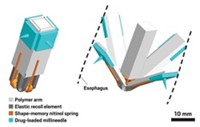Advertisement
Grab your lab coat. Let's get started
Welcome!
Welcome!
Create an account below to get 6 C&EN articles per month, receive newsletters and more - all free.
It seems this is your first time logging in online. Please enter the following information to continue.
As an ACS member you automatically get access to this site. All we need is few more details to create your reading experience.
Not you? Sign in with a different account.
Not you? Sign in with a different account.
ERROR 1
ERROR 1
ERROR 2
ERROR 2
ERROR 2
ERROR 2
ERROR 2
Password and Confirm password must match.
If you have an ACS member number, please enter it here so we can link this account to your membership. (optional)
ERROR 2
ACS values your privacy. By submitting your information, you are gaining access to C&EN and subscribing to our weekly newsletter. We use the information you provide to make your reading experience better, and we will never sell your data to third party members.
Drug Delivery
A birth control pill lasts one month in pigs. Will it work in humans?
The researchers use a slowly dissolving polymer matrix to release hormones over one month
by Megha Satyanarayana
December 11, 2019

Rings, patches, injections, and implantable devices—these are some of the long-acting birth control delivery systems that women can use to prevent pregnancy.
The devices release tiny amounts of synthetic estrogen and progesterone, preventing an egg from being released and all but assuring sperm cannot complete their biological directive.
What’s missing from this list is a long-acting oral contraceptive. A team of scientists at the Massachusetts Institute of Technology led by Robert Langer and Giovanni Traverso think they can fill that gap. Using a device shaped like a six-sided star, the research team has created an oral birth control option that, in pigs, lasts for about a month (Sci. Transl. Med, 2019, DOI: 10.1126/scitranslmed.aay2602).
Ameya Kirtane, who did much of the research to develop the contraceptive delivery system, explains that their technology meets two needs: patient preference for oral contraceptives and eliminating daily dosing, which decreases the chance a person will forget to take the drug. The star is packed with hormone analogs embedded in polymers. The device folds up into a gelatin capsule that can be swallowed and then resides in the stomach. When it hits the stomach, Kirtane says, it pops open, unfurling the star, which then spits out a small amount of drug each day.
The delivery vehicle is flexible, not only to fit in a capsule, but also to withstand the grinding forces of the stomach and to keep it from escaping the stomach into the intestines, Traverso says. The star arms connect to an elastic core, and while it is bigger than the opening that leads to the intestines, it doesn’t impede the movement of food and liquid out of the stomach during digestion, Kirtane says.

“If you think about the star when it opens up, it still can allow things to pass across it,” Kirtane says. “That helps us to prevent any sort of blockage.”
The team tested the device loaded with the common contraceptive levonorgestrel in pigs. Pigs’ organ systems are similar in size and shape to humans, but the animals do metabolize drugs differently than humans, Traverso says. In pigs given the device, the researchers could detect picomolar concentrations of the compound in the pigs’ bloodstreams for up to 29 days. In pigs given the standard levonorgestrel pill, the team could detect the hormone for only up to 48 hours. The researchers did not test whether the device prevented pregnancy in the pigs, Traverso says.
The device has two layers, a rigid outer polymer and an inner drug-polymer matrix. The team tested two inner matrices—levonorgestrel with poly(dimethylsiloxane) (PDMS) and levonorgestrel with poly(sebacic anhydride). PDMS seemed to release the drug more slowly than poly(sebacic anhydride), suggesting it might be the better polymer for slow release.
The technology is interesting, says Deborah Anderson, a clinician and scientist at Boston University Medical Center who is working on antibody-based contraceptive devices, but she has a lot of questions about whether the device will work in humans and whether people will prefer it over existing systems.
“We do need more contraceptive options,” Anderson says, explaining that when women miss daily birth control pills, the efficacy of the drug in preventing pregnancy drops from 99% to 90%, “but I’m not sure this one will have more impact.”
In many developing countries, where the need is greatest, many women do not like to use birth control pills, Anderson says. She’s been told that women dislike the pills because their side effects are less tolerable compared with those from other forms of contraception such as injectable contraceptives. And in developed nations, women have many choices for long-acting birth control already (New Engl. J. Med. 2019, DOI: 10.1056/NEJMp1906733).
Using the same general system, Kirtane says, the MIT team has been able to deliver HIV drugs and antimalarial drugs for 1 to 2 weeks. The early work on the device has been funded by the Bill and Melinda Gates Foundation, and Langer has created a company called Lyndra to develop the star for clinical use. Human trials for an Alzheimer’s drug-delivery system have begun, Traverso says, but trials have not started yet for HIV, malaria, and contraception.
“There is really no limitation in terms of what disease area you want to pursue, as long as you have a drug that is potent enough,” Kirtane says, noting that there is a limit to how much drug the system can hold.
Anderson is curious how human trials of the drug delivery device will go—will the hormones last as long in people as they do in pigs? Will there be similar side effects, such as nausea and weight gain, as seen in daily hormonal birth control pills? Will it prevent pregnancy? She also sees a problem this device will have that other systems do not have. If a woman has bad side effects with some of the other long-acting contraceptives, like the ring or a patch, they can be removed. As for the star-shaped device, “I don’t see it being readily reversible in the face of side effects.” Traverso says they can engineer the system to be quickly digested if need be.
In the meantime, Anderson says, if the technology can be used to deliver other drugs, she has an idea for a once-a-month drug in perhaps a less-crowded market.
“How about a male contraceptive?” she asks, noting that several molecules that could work with the device are already in clinical trials.





Join the conversation
Contact the reporter
Submit a Letter to the Editor for publication
Engage with us on Twitter